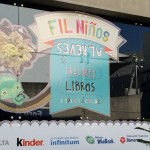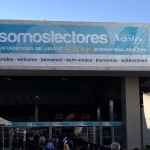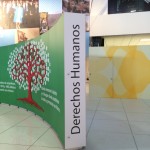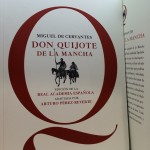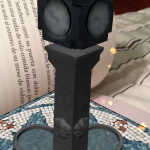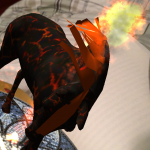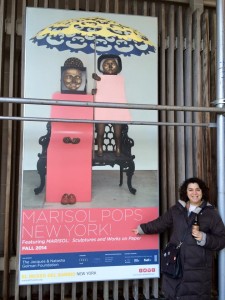From November 29th to December 4th, I had the opportunity to attend FIL in Guadalajara, Mexico, the biggest book fair in the Americas and the second biggest in the world (the biggest is in Germany, the Frankfurt International Book Fair). I was able to attend partly thanks to ALA-FIL travel grant, which paid for hotel, book fair registration and breakfast, and our library which support me by paying for airfare.
ALA has for many years partnered with the Mexican government and the FIL coordinators to bring American librarians, both from the public and academic sector, to the fair as a way to improve the quality of American libraries by being able to buy directly, not only from Mexican publishers, but also from publishers from all over Latin America, the Caribbean and even Europe and Asia.
It has been almost two years since my last visit to the FIL so I have a lot to catch up in the buying department. Because I arrived during the weekend I was able to get an early start. First thing I did was to visit the stands of several Central American countries. Central American countries (Costa Rica, Guatemala, Nicaragua, etc.) had small print runs so if you don’t get their books early they may run out before you have visited their stand! My diligence paid off and I was able to acquire several interesting books from novels to social sciences studies about immigration, politics, economy and gender and human rights issues. Other country that I visited early was Peru which had several books I wanted. Unfortunately, I couldn’t buy all of them in my first day since some of them were not ready for sale. One of the major activities at the book fair was to present new books—there were 590 of such presentations—with a formal ceremony and a discussion leaded by experts of the field who discussed the value of the book to the public. After the ceremony, you can buy the book—which I did!
Because the fair is so huge—the convention center is the size of a football stadium— and there were so many stands—1,945 publishers attended the fair— I decided to plan my week based on the countries I wanted to visit and not to spend all my budget in one day. During my visit I bought books from Cuba, Bolivia, Colombia, Costa Rica, Ecuador, Guatemala, Chile and Peru on such subjects as immigration, gender studies, social justice, human rights, social movements, labor and literature. In addition, I asked my Mexican distributor to make a selection of Mexican books sold only in the FIL—since Mexico by itself take over half of the convention center!
I think this strategy helped me focused on the countries we don’t purchase many books because of cost and/or availability, while my distributor used a purchasing profile for Mexico that I gave him so he could acquire the type of materials my users need. This profile is based on the feedback I received from my constituents about their research and teaching needs in Latin American & Caribbean Studies, Anthropology, History, Political Sciences, Human Rights and Spanish. I have profiles for each country that we have consistently acquired materials through the years, and I have added new countries as new faculty and research interests had shifted since I started working in 2007. Using these profiles, I made purchases decisions trying my best to balance between “just in case” and “just in time” philosophies while at the book fair.
Just to give you an idea of the size and the amount of people that attend this book fair, here are some figures from the FIL website for this 2014 book fair.
- Attending Public: 767,200
- Book Professionals (librarians, dealers): 20,393
- Publishing houses: 1,945
- Countries represented by publishing houses: 44
What are the benefits of attending a book fair?
- Talking directly with the different publishers from each of these countries help me identify emerging areas of interest that may have not reached the US academia yet, e.g. promising new authors that have won national or regional awards, new mixed media and literature genres such as encoded images in fantasy fiction. For example, I found a novel, Fuego Lento by Costa Rican writer Jessica Clark, which incorporated a code inside the illustrations used in the book cover and each chapter divider. When using the right apps in your smartphone, you can see 3-D images on the phone screen–like an animation jumping out of the page–which enhances the reading experience of this tale of apocalyptic proportions set in San Jose, Costa Rica.
- Being able to buy books for a fraction of what it would cost us to obtain them through a distributor. For example, I have the pleasure to meet Agustina Ponce, the director of Ediciones Vigía, one of the most famous homemade/artists’ book publisher in Cuba. Usually these books are hard to find in the US, and when you get them, you paid between a 300-400% mark-up. This time around, since I met directly with the publisher, I was able to pay the actual cost of these books and saved us quite a bit of money.
- Meeting fellow librarians from the US and Mexico and exchange news and ideas about how to best approach buying books in the fair.
- Learning about new trends such as the ebooks market is another plus of attending the fair–mainly the emphasis is in popular fiction but there is some interest to expand into the academic sphere.
- Finally, there is nothing more satisfying to be in a book fair and walk among thousands of books and seeing young and old, buying and reading books! Paradise on Earth!
Final observations: Even though this was a well-attended book fair and the usual amount of countries were presented, there were less books sold at the fair compared with past years. I asked some of the vendors why they had fewer books in their stands this time around and many replied that because an increase in shipping cost they brought half of the amount of what they usually bring. So, it was a good thing that I attended early to be able to acquire as many books I could since otherwise I could have missed out on many great titles.
I should be getting all the books from the book fair by the end of this month and I plan to create lists in WorldCat of what I acquired at the fair to share with my faculty. I hope to do a “Show and Tell” later to showcase some of the books that I acquired with my faculty. Finally, I am working with Prof. Odette Casamayor to do a small exhibition using books from Ediciones Vigía to showcase the books I acquired during this trip and others that we already have at the archives.
I can go on talking about the book fair but I will stop here. Please enjoy the photos I took during my visit and if you have questions about my trip feel free to contact me anytime.
- Entrance to Book Fair
- Entrance to Book Fair
- Argentina was the Country Guest of Honor. Here, several panel of the comic Mafalda, one of the most iconic comics in Argentina and Latin America
- As part of the Argentina display, several panels showcase important elementos of its history, including human rights issues and desaparecidos
- One of the highlights of my trip, seeing one of my favorite Spanish writers, Arturo Pérez-Reverte!
- Arturo Pérez-Reverte was at the FIL as part of the presentation of his new work, a modern adaptation of El Quijote sponsored by the Royal Academy of Spain
- Ivan Camilano from Digitalia (we have a pilot project for Spanish ebooks right now)
- Fuego Lento by Jessica Clark (Costa Rica)
- 3-D images coming out of my iPhone while reading Fuego Lento (That is my bed cover)
- 3-D images coming out of my iPhone while reading Fuego Lento
- 3-D images coming out of my iPhone while reading Fuego Lento. You can take pictures while seeing this graphics, that is the reason my cat Bella made it into this picture

